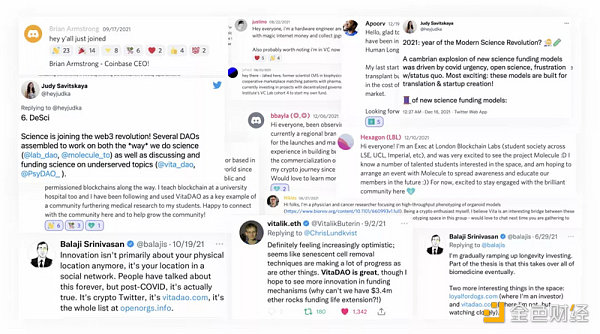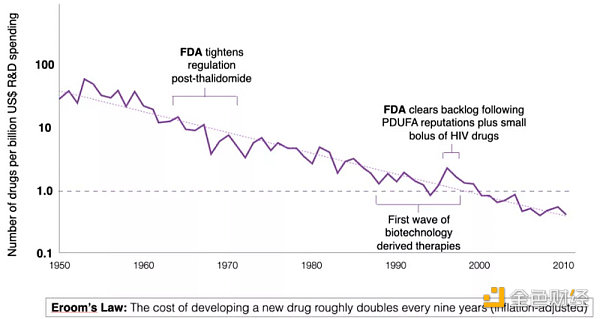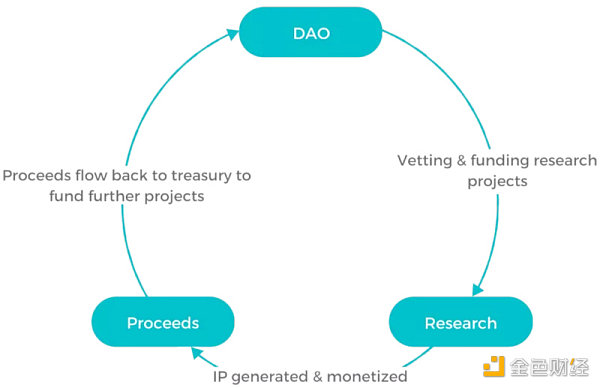How can biotechnology DAOs design their architecture to break the pharmaceutical deadlock?
Original Title: "The Rise of Biotechnology DAOs: Exploring Their Design Space and Framework"
Original Author: DAOrayaki
The Rise of Biotechnology DAOs
A thriving decentralized science (DeSci) movement is transforming the landscape of the biopharmaceutical industry, fostering the formation of patient- and researcher-centered communities based on open-source principles.

Breaking the Eroom's Law
We are all familiar with Moore's Law— the number of transistors on a dense integrated circuit doubles approximately every two years, which roughly describes the exponential growth of computing power over time. Eroom's Law (the inverse of Moore's Law) refers to the fact that despite technological advancements, the speed of drug development is slowing down, and costs are rising. While technologies such as high-throughput screening, combinatorial chemistry, and computational drug design can accelerate innovation, other systemic and institutional issues hinder progress, such as increased regulatory burdens, a lack of open-source technology sharing, and misallocation of capital by existing companies, which obstructs new drugs from entering the market and thus hinders patients.

One potential explanation for this trend is the failure of capital and resource coordination, compounded by the monopolistic intellectual property models prevalent in pharmaceuticals and biotechnology. These models suppress information sharing and collaboration, obfuscate data production, and create contradictions in experimental results. While new laboratory technologies alone cannot improve the efficiency of drug development, we believe that new advancements in network, coordination, and incentive technologies at the structural level can reverse this trend by optimizing collaboration, talent, and capital allocation in novel ways.
Historically, biotechnology and pharmaceuticals have been centralized in the form of large companies and organizations, lacking incentives to work in an open and collaborative manner. In other words, pharmaceutical companies have a "closed-source" culture. The trend toward decentralization is overturning the power monopolies of centralized entities, shifting toward a network of collaborators coexisting in a flatter hierarchical structure.
Decentralized communities achieve common goals by sharing resources prior to competition within the community. They promote an open-source culture among their members and encourage collaboration using token-based mechanisms.
Decentralized networks provide a trustless environment where data coordination is improved, weaknesses are reduced, and resource distribution is optimized on a large scale. In the context of biotechnology, this means creating new organizational structures with lower barriers to entry (e.g., logging into Discord), inherent collaboration, and incentive mechanisms (WAGMI), which can coordinate funding and work from any participant (including the general public and patients). These characteristics manifest in the form of decentralized autonomous organizations (DAOs).
DAOs are relatively new entities based on smart contracts that can coordinate capital, talent, and collective intelligence on an unprecedented scale. Recently, a new decentralized science (DeSci) movement has rapidly changed the way science and biotechnology are coordinated by leveraging DAOs (see VitaDAO, PsyDAO, labDAO), with Molecule increasingly positioned as a core infrastructure provider in this field.
The DeSci movement is currently forming a talent pool for entrepreneurial researchers and leading thinkers in the biotechnology innovation space who are frustrated with the status quo, whether it be funding, coordination, collaboration, or other systemic issues affecting young entrepreneurs and scholars in biotechnology. For example, the National Institutes of Health (NIH) allocates only 2% of its funding to scientists under 36, while those 36 and older receive 98% of the funding. Among other things, this trend has led to enough frustration to give rise to several new organizational types, such as FROs and DAOs, aimed at fundamentally changing the biotechnology field. But what exactly is a DAO? Why is it important, and how will it change biotechnology?
Design Space of Biotechnology DAOs
Let’s begin to understand biotechnology DAOs by looking at the steps to create a DAO and their functions. A suitable starting point for biotechnology DAOs is a clear vision and mission—what can these new, open organizational frameworks achieve? Biotechnology DAOs can coordinate talent, enable decentralized fundraising and governance, or help create standardized data collection and generation methods, among other things. They can be charitable or for-profit. Although biotechnology DAOs have limitless design space, their key innovation lies in the lack of gatekeeping ability and the use of technology to coordinate decision-making in large communities.
All biotechnology DAOs share one commonality: they address a problem that has remained unsolved due to the lack of incentive mechanisms for widespread collaboration in the biotechnology field.
To better understand this, we can take the example of VitaDAO, the first biotechnology DAO born from Molecule. VitaDAO focuses on funding early preclinical drug development in the context of longevity. When designing VitaDAO, Molecule aimed to:
Create a Schelling point and community-building activities at the intersection of longevity and Web3, allowing researchers and the public to gather and participate in research and funding.
Fund cutting-edge, high-impact research in academia and help translate this research into effective drugs.
Establish a sustainable organization as a function of its commercial efforts, with proceeds from these efforts providing a continuous funding mechanism for longevity science.
The third point, "a sustainable organization as a function of its commercial efforts," requires the DAO to derive monetary value from its funding efforts. To this end, VitaDAO leverages Molecule's IP-NFT framework, which allows the DAO to own, license, and trade the intellectual property generated from the projects it supports. VitaDAO is committed to funding early research in academia and commercializing it. For the first time, a large, decentralized community composed of researchers and patients has gained value.

NFTs enable us to capture various types of assets, including IP rights and data, and manage them natively in Web3. Web3 allows these assets to exist in cyberspace, meaning you can interact with them in some way regardless of which country you are in, crossing borders, time zones, and jurisdictions. This is a significant step toward democratizing access to these assets. NFTs can be transferred to another wallet, tokenized, collateralized, and lent, sold on NFT marketplaces, and programmed so that the original creator automatically receives royalties each time the NFT is resold.
At Molecule, the groundbreaking IP-NFT framework connects IP and data to NFTs, turning IP into a new highly liquid, tradable asset class that links Web3 to the real world. The design here is still in its early stages, and these new tools will need to withstand the test of time and courts. Early data shows that these methods are effective.
BioDAO Framework
VitaDAO is the first design of a biotechnology DAO. One of Molecule's core goals is to create a productized biotechnology DAO framework that allows anyone to build and operate their own biotechnology DAO and start leveraging a large, open community to achieve their goals. To this end, Molecule is seeking to collaborate with proactive researchers, patient groups, entrepreneurs, community builders, and visionaries who are eager to build at the intersection of biotechnology and Web3.
We envision these structures becoming tools for shaping patient and researcher communities. Imagine a patient- and researcher-centered BioDAO focused on Alzheimer's research, specific types of cancer, or diabetes, where there is a tight feedback loop and collaboration between patients and researchers throughout the entire end-to-end drug development process, from funding to licensing.
At Molecule, we believe our core responsibility is to assist builders in the following areas:
Enabling biotechnology DAO builders to leverage our IP-NFT legal licensing framework and DAO organizational framework. We will support their efforts to collaborate with scholars through Molecule's marketplace.
Funding from the right sources. We will provide liquidity and support for projects in the form of grants and token swaps. WAGMI.
Providing a talent pool that can move between DAOs, helping to build and guide all components of the DAO: finance, governance, operations, strategy, marketing, education, and search/evaluation. We have a network of researchers, entrepreneurs, builders, biotech venture capitalists, and enthusiasts to help build the best possible organizations.
Helping establish a robust global legal framework suitable for specific biotechnology and patient-centered DAO communities, such as the for-profit LAO framework pioneered by Tribute Labs or the non-profit Swiss association.
PsyDAO will be the second biotechnology DAO launched by Molecule, with the ultimate goal of popularizing psychedelics. We aim to achieve this core goal through several related avenues. The first approach is to bring together researchers, opinion leaders, enthusiasts, and spiritual leaders to collaboratively decide the future of psychedelic research. This group will collectively fund psychedelic research in exchange for ownership of intellectual property, which will be open-source and available for everyone to use or commercialize. A key objective is to strive to prevent the monopolization of psychedelic intellectual property by acquiring publicly available intellectual property before it is patented, for example, this design principle differs slightly from that of VitaDAO.
Others in the ecosystem are also beginning to establish biotechnology DAOs that serve entirely different functions beyond just funding. A major example here is LabDAO. LabDAO is building a community-owned and operated platform for scientific laboratory services, protocol exchange, and data sharing. These organizations have high interoperability and collaborative potential.
You can imagine a scenario where organizations like VitaDAO acquire assets in the form of IP-NFTs from Molecule's discovery marketplace. VitaDAO funds early preclinical experiments to eliminate risks. Once positive data emerges and new experiments are needed, which may exceed the scope of the funded laboratory, LabDAO (a laboratory community) intervenes to coordinate downstream development work and experiments through other academic laboratories and CROs. Decentralized drug development begins to take shape. Furthermore, IP-NFTs allow different contributors (such as LabDAO members) to gain ownership of IP in exchange for their work. These organizations begin to form a modular, decentralized drug development pipeline, with each organization leveraging its strengths and being rewarded for its contributions.
All these parts come together to start forming the foundation of a collaborative, open, and inclusive ecosystem with the potential to permeate and change the monopolistic behaviors in biotechnology, making it more aligned with the interests of patients and researchers. This is the beginning of a new realm in biotechnology, and this is just day one.
For an Open BIO Ecosystem for Humanity
We hope to assist all those who share our dream of an open drug system. Currently, we are helping to establish biotechnology DAOs such as:
VitaDAO—focused on funding longevity research
PsyDAO—focused on funding psychedelic research
Drug Reuse DAOs, such as Crowdfunding Cure
DAOs for rare disease communities
At Molecule, we provide:
DAO and Web3 frameworks
Practical community development strategies
Legal frameworks
Tokenomics design
Liquidity
We intend to provide funding and liquidity to DAOs, enabling them to compete with current venture capital and pharmaceutical models.
Also, be sure to check out LabDAO—one of the most exciting new players in the DeSci community.
This is day one. Join us in building the future of biotechnology.
Reference Links
VitaDAO: https://vitadao.com/
PsyDAO: https://www.psydao.io/
labDAO: https://www.labdao.com/
Molecule: https://www.molecule.to/
IP-NFT: https://medium.com/molecule-blog/molecules-biopharma-ipnfts-a-technical-description-4dcfc6bf77f8
LabDAO: https://www.labdao.com/
Molecule: https://linktr.ee/molecule_to










